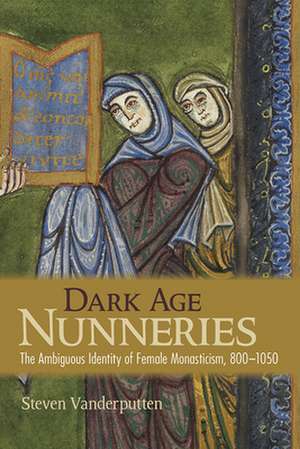Dark Age Nunneries – The Ambiguous Identity of Female Monasticism, 800–1050
Autor Steven Vanderputtenen Limba Engleză Paperback – 14 mai 2018
Rather than a "dark age" in which female monasticism withered under such factors as the assertion of male religious authority, the secularization of its institutions, and the precipitous decline of their intellectual and spiritual life, Vanderputten finds that the post-Carolingian period witnessed a remarkable adaptability among these women. Through texts, objects, archaeological remains, and iconography, Dark Age Nunneries offers scholars of religion, medieval history, and gender studies new ways to understand the experience of women of faith within the Church and across society during this era.
| Toate formatele și edițiile | Preț | Express |
|---|---|---|
| Paperback (1) | 315.18 lei 6-8 săpt. | |
| MB – Cornell University Press – 14 mai 2018 | 315.18 lei 6-8 săpt. | |
| Hardback (1) | 724.19 lei 6-8 săpt. | |
| Wiley – 14 mai 2018 | 724.19 lei 6-8 săpt. |
Preț: 315.18 lei
Nou
60.32€ • 62.49$ • 50.34£
Carte tipărită la comandă
Livrare economică 22 martie-05 aprilie
Specificații
ISBN-10: 150171595X
Pagini: 330
Ilustrații: 11 Halftones, black and white; 3 Maps
Dimensiuni: 161 x 227 x 20 mm
Greutate: 0.48 kg
Editura: MB – Cornell University Press
Descriere
In Dark Age Nunneries, Steven Vanderputten dismantles the common view of women religious between 800 and 1050 as disempowered or even disinterested witnesses to their own lives. It is based on a study of primary sources from forty female monastic communities in Lotharingia-a politically and culturally diverse region that boasted an extraordinarily high number of such institutions. Vanderputten highlights the attempts by women religious and their leaders, as well as the clerics and the laymen and -women sympathetic to their cause, to construct localized narratives of self, preserve or expand their agency as religious communities, and remain involved in shaping the attitudes and behaviors of the laity amid changing contexts and expectations on the part of the Church and secular authorities.
Rather than a "dark age" in which female monasticism withered under such factors as the assertion of male religious authority, the secularization of its institutions, and the precipitous decline of their intellectual and spiritual life, Vanderputten finds that the post-Carolingian period witnessed a remarkable adaptability among these women. Through texts, objects, archaeological remains, and iconography, Dark Age Nunneries offers scholars of religion, medieval history, and gender studies new ways to understand the experience of women of faith within the Church and across society during this era.


